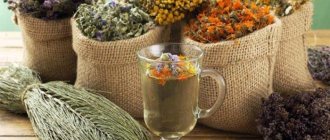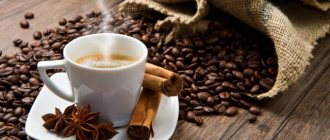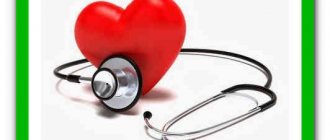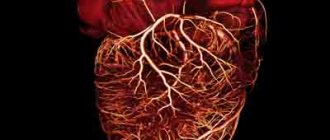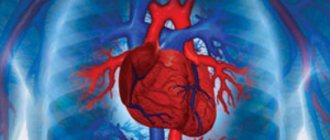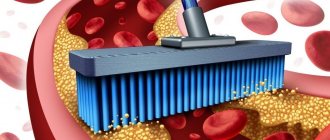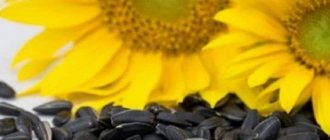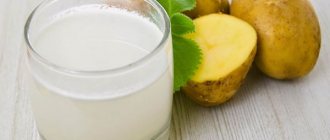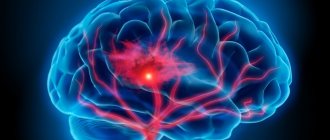DlyaSerdca → Heart Diseases → Ischemia → Traditional methods and recipes in the treatment of coronary heart disease
Coronary heart disease (angina pectoris, cardiosclerosis) causes spasmodic pain in the heart area. This disease has a chronic course. Exacerbation of the disease can cause myocardial infarction.
Therefore, this disease is very dangerous, and the sooner it is diagnosed and treatment is started on time, the better.
IHD is caused by impaired blood supply to the heart due to narrowing of the patency of the coronary arteries.
This mainly happens due to sclerosis or vascular thrombosis. The disease may not make itself felt for a long time. Mostly, people go to the doctor when they feel heart pain, arrhythmia of the heart rate and surges in blood pressure.
Vascular atherosclerosis
You need to consult a doctor and conduct a full diagnosis if signs of coronary heart disease appear. The doctor will be able to determine the stage of the disease and prescribe medication, physiotherapy and exercise therapy. In addition to traditional medicine, there are many folk remedies and methods for treating coronary artery disease.
A little about the benefits of plants
With myocardial ischemia, the blood supply to the heart muscle is disrupted and oxygen starvation of the tissues occurs, which is why the organ cannot function fully (angina pectoris often occurs and such a terrible complication as a heart attack). A person experiences chest pain, palpitations, or even a feeling of irregular heart rhythm.
There is a huge list of herbs that can alleviate the patient’s condition:
- Hawthorn helps strengthen the myocardium, increases the strength of heart contractions, and improves blood movement through the coronary vessels. The ability of hawthorn to relieve pain arising from angina pectoris and eliminate attacks of arrhythmia has been noted. The beneficial substances contained in the plant strengthen the vascular wall and prevent the deposition of atherosclerotic plaques.
- Rose hip. The berries of this plant are mainly used as a source of vitamin C. But not everyone knows that regular use of rosehip decoction normalizes high blood pressure, strengthens blood vessels and improves blood circulation in organs.
- Melissa. It has been noticed that people who put this herb in tea for taste almost never suffer from anemia or heart disease. The plant is rich in elements necessary for the myocardium (magnesium, manganese, potassium, etc.) and vitamins. Regularly adding lemon balm to tea or taking it as an infusion helps get rid of dizziness, improves blood circulation and allows you to forget about arrhythmia.
- Horsetail. Many people know it as a herb that helps with kidney disease and has diuretic properties, but horsetail is also useful for cardiac ischemia. The plant is rich in substances that strengthen the heart muscle, helps prevent the development of atherosclerosis and relieves swelling.
There are many “heart” plants, but to describe them you will need a book. Only proper use can bring health benefits. Therefore, it is important to maintain proportions when compiling fees.
Lifestyle with coronary heart disease
If you have IHD, an active lifestyle is important; doing light sports will help improve blood circulation, improve heart function and the general condition of the patient. Strong physical activity is unacceptable, as overwork has a bad effect on the functioning of the heart. A set of simple exercises, swimming, skiing, light jogging will help you get rid of excess weight (if any) and keep your heart in working condition. With a passive lifestyle, blood circulation worsens, which leads to oxygen starvation of the myocardium. Therefore, exercise therapy is an integral part of the treatment of ischemia.
It is equally important to change your diet. It is necessary to exclude foods rich in animal fats, as they are the main supplier of cholesterol to the human body.
Fatty pork should be replaced with veal, chicken or turkey. Eggs can be present in the diet, but their quantity should be limited. You need to completely avoid fried foods and replace them with stewed or boiled foods.
Potassium and magnesium are simply necessary for the smooth functioning of the heart, so you need to include foods rich in these elements in your diet. There is a lot of potassium in jacket potatoes, dried apricots, raisins, nuts, dairy products, and prunes. Pomegranates are considered record holders for magnesium content; bananas also contain a lot of it. You need to eat more fruits and vegetables, as they contain substances and vitamins that affect the functioning of the heart.
It is important to give up bad habits; smoking and alcohol have never made anyone healthier. Considering that ischemia is mainly a male disease, the last recommendation is very relevant. It must be remembered that with ischemic heart disease, sudden cardiac arrest is possible. Therefore, quitting smoking and alcohol will reduce the risk to a minimum.
Centuries-tested medicinal recipes
To relieve the symptoms of IHD, both one plant and several components included in the collection are used. Both of these methods are equally successfully used in alternative medicine.
Monophytotherapy
Herbal monotherapy (only one component is used) is quite often prescribed for pathologies of the cardiovascular system.
- Fennel. Pour 10 g of fruit into a glass of boiling water, then wait until it cools and strain. Drink a tablespoon 3-4 times a day to improve blood supply to the myocardium.
- Dill. Pour 300 g of boiling water over the herb or seeds of this seasoning (about a tablespoon) and leave. After filtering, drink the resulting liquid throughout the day. Helps prevent angina attacks.
- Hawthorn. An arbitrary amount of berries is brewed with boiling water and drunk as tea. You can add honey or sugar to improve the taste.
- Rose hip tincture. Pour about 500 g of berries with vodka and leave in the dark for 2 weeks. Apply 20 drops to a piece of refined sugar and eat sugar three times a day.
- Dandelion juice. Dig up the plant by the roots, wash it and grind it in a meat grinder. Place the resulting mass on cheesecloth and squeeze out the juice. Take 3-4 times a day, 30 drops. The product cleanses blood vessels and improves blood supply to the myocardium. You can also eat the leaves by adding them along with other greens to salads.
- Swamp dry grass. A tablespoon of raw material is poured into a glass of water and simmered in a water bath for 15 minutes. The resulting liquid is filtered and drunk after meals during the day. Helps get rid of symptoms such as a feeling of constriction and pain in the chest that occurs during an attack of angina.
Each herb has specific properties and is used to relieve bothersome symptoms. If you manage to choose “your” plant, then you can drink decoctions or teas from it for a long time. Probably everyone has heard a neighbor or colleague praise the miracle herb that helped her with heart disease. This is the case when plant materials provided the organ with the necessary elements to improve the nutrition of the heart muscle.
Forecasts
Traditional methods in the treatment of coronary heart disease give a positive effect only if you adhere to proper nutrition and eliminate risk factors .
Long-term treatment can significantly improve the patient's condition . Often the number of attacks and exacerbations of the disease decreases, and in some cases disappears altogether.
To improve the condition of cardiac muscle ischemia, it is necessary to perform a set of actions aimed at adjusting lifestyle and nutrition. This approach increases the effectiveness of therapy with folk remedies.
Properly selected herbal medicine will allow you to gradually abandon pharmaceuticals and maintain health using natural remedies.
Treatment with herbal teas
To eliminate several symptoms, infusions of herbs, roots and berries are used. Before mixing, dry plant materials are thoroughly crushed.
Recipe 1
Combine in equal proportions:
- Birch buds;
- elecampane tall;
- corn silk;
- buckwheat;
- cornflower;
- bearberry leaves.
2 tbsp. l. dry mixture is poured with water and brought to a boil in a water bath, then infused. The resulting portion of the infusion is divided in half and drunk in the first half of the day, 30 minutes before meals.
The composition improves myocardial function and has a general tonic effect.
Diagnostic features
The main method for diagnosing ischemia is daily ECG monitoring. It is recommended for patients with a high functional class of stable angina pectoris, unstable angina and post-infarction cardiosclerosis, as well as persons without clinical symptoms of ischemia in the presence of several risk factors simultaneously. In a number of patients, the sign of ST segment elevation on the ECG can be detected during an exercise test, as well as during stress echocardiography.
Preventive measures
There are primary and secondary prevention of ischemia.
Primary prevention of coronary heart disease consists of carrying out special measures before the onset of the disease (impact on risk factors to slow the progression of the atherosclerotic process).
Secondary prevention in a patient with ischemia is carried out in the presence of an existing disease to prevent the progression of the disease and prevent subsequent complications. Currently, secondary prevention predominates, since primary prevention requires public policy on a healthy lifestyle.
Risk factors – who should be afraid?
Existing risk factors for coronary disease are divided into modifiable (modifiable) and non-modifiable (constant, non-modifiable).
Family history of coronary artery disease
The risk of developing ischemia is increased:
- in close relatives of a patient with IHD (more important for first-degree relatives - parents, brothers, sisters, sons, daughters, than for second-degree relatives - uncles, aunts, grandparents);
- with a large number of sick people in the family;
- when IHD occurs in relatives at a relatively young age.
Age
A linear relationship was revealed between age and signs of disease (the older the age, the more pronounced atherosclerosis and the higher the incidence).
Floor
Up to 55 years of age, the incidence of ischemia among men is 3-4 times higher than among women (with the exception of women suffering from arterial hypertension, hyperlipidemia, diabetes mellitus, and early menopause). After 75 years, the incidence of coronary heart disease among men and women is the same.
Smoking
Smoking increases the possibility of developing coronary heart disease by 2 times. Smoking causes a transient increase in fibrinogen levels in the blood, narrowing of the coronary arteries, platelet aggregation, a decrease in HDL cholesterol levels in the blood, and an increase in the concentration of LHT cholesterol. In addition, substances contained in tobacco smoke can damage the endothelium and promote the proliferation of smooth muscle cells (ultimately forming foam cells). According to autopsy data, in smokers who died from causes unrelated to ischemia, atherosclerosis of the coronary arteries is more pronounced than in non-smokers. Smoking cessation leads to a 50% reduction in the incidence of myocardial infarction in the population. However, smoking has a major effect on the incidence of sudden cardiac death.
Quitting smoking leads to a reduction in the likelihood of cardiovascular disease, which can reach the level for non-smokers within one year of abstinence.
Signs of arterial hypertension
High blood pressure (both systolic and diastolic) increases the risk of morbidity by 3 times.
Diabetes
In type I diabetes mellitus, insulin deficiency leads to a decrease in the activity of LGOTases and, accordingly, to an increase in the synthesis of triglycerides. In type II diabetes mellitus, there is type IV dyslipidemia with increased VLDL synthesis. In addition, diabetes mellitus is often combined with obesity and arterial hypertension.
Sedentary lifestyle
A sedentary lifestyle significantly increases the likelihood of developing CHD.
Obesity
Obesity predisposes to symptoms of dyslipidemia, hypertension and diabetes mellitus.
Estrogen deficiency
Estrogens have a vasoprotective effect. Before menopause, women have higher levels of LHT cholesterol, lower concentrations of LDL cholesterol, and are 10 times less likely than men of the same age. During menopause, the protective effect of estrogens decreases and the likelihood of coronary artery disease increases (which dictates the need to replenish estrogens from the outside).
Risk factor assessment
The presence of several such moments leads to signs of an increase in the likelihood of developing ischemic disease of the main muscle several times, and not simply to the summation of the degrees of risk. When assessing the possibility of developing coronary heart disease, the following parameters are determined:
- Unchangeable factors are age, gender, family history, and the presence of atherosclerotic manifestations.
- The patient’s lifestyle—smoking, physical activity, dietary habits.
- The presence of other factors - excess body weight, arterial hypertension, lipid and glucose levels in the blood.
To assess body weight, you can focus on such a sign as body mass index - the ratio of body weight (in kg) to body surface area (in m2).
Secondary prevention
Secondary prevention in a patient with coronary artery disease consists of changing lifestyle, influencing risk factors, and using JTC.
- Lifestyle change
- Stop smoking.
- Dieting.
- Reducing the consumption of animal fats to 30% of the total energy value of food.
- Reduce saturated fat intake to 30% of total fat.
- Cholesterol intake no more than 300 mg/day.
- Replacing saturated fats with polyunsaturated and monounsaturated fats of plant and marine origin.
- Increasing consumption of fresh fruits, plant foods, cereals.
- Limiting total calorie intake if you are overweight.
- Reducing salt and alcohol consumption with high blood pressure.
- Increase physical activity. The following physical exercises are recommended: brisk walking, jogging, swimming, cycling and skiing, tennis, volleyball, dancing with aerobic physical activity. In this case, the heart rate should be no more than 60-70% of the maximum for a given age. The duration of physical exercise should be 30-40 minutes: 5-10 minutes warm-up, 20-30 minutes aerobic phase, 5-10 minutes final phase. Regularity: 4-5 times a week (for longer sessions - 2-3 times a week).
Impact on risk factors
If your body mass index is more than 25 kg/m2, you need to lose weight through diet and regular exercise. This leads to signs of decreased blood pressure, a decrease in the concentration of total cholesterol and LDL cholesterol in the blood, an increase in HDL cholesterol, an increase in glucose tolerance and insulin sensitivity.
For elevated blood pressure, antihypertensive drugs are prescribed if there is no effect from non-drug therapy. Blood pressure below 140/90 mmHg is considered optimal. Art.
In case of hypercholesterolemia or a complex form of dyslipidemia, it is necessary to reduce the concentration of total cholesterol to 5 mmol/l (190 mg%) and LHTDL cholesterol to 3 mmol/l (115 mg%) using dietary measures, and then using antihyperlipidemic drugs (especially in the presence of severe manifestations of ischemic heart disease). After myocardial infarction, the prescription of antihyperlipidemic drugs is recommended 3 months after its occurrence (the time necessary to stabilize blood lipid levels and evaluate the effect of dietary measures).
In the presence of signs of type I diabetes mellitus, the optimal glucose concentration is considered to be 5.1-6.5 mmol/l (91-120 mg%), the optimal peak glucose concentration is 7.6-9 mmol/l (136-160 mg%). Prevention of serious hypoglycemic conditions is also necessary. For patients with type 1 diabetes mellitus, lower blood glucose values are recommended.
Application of drugs
- Acetylsalicylic acid (minimum dose 75 mg).
- Beta blockers are necessary for patients after myocardial infarction (especially with complications during myocardial infarction in the form of arrhythmias), even in the absence of angina.
- ACE inhibitors are indicated for patients after myocardial infarction with signs of heart failure or left ventricular dysfunction.
- Anticoagulants are indicated for patients after myocardial infarction with an increased risk of thromboembolism.
Primary prevention
The absolute risk of developing coronary disease in the next 10 years can be assessed using special coronary risk maps developed by the International Societies for Coronary Prevention. To do this, it is necessary to determine such characteristics as age, gender, smoking habit, systolic blood pressure and total cholesterol concentration.
Primary prevention is carried out in individuals with an increased likelihood of developing coronary artery disease. Measures for primary prevention of coronary artery disease consist of changing lifestyle and influencing risk factors. They are similar to the above measures for secondary prevention of coronary artery disease.
Silent ischemia is understood as a condition in which the presence of ECG symptoms is not accompanied by pain. In this article we will look at the manifestations and basics of therapy.
Recipe 2
Take equal parts:
- chamomile;
- hawthorn;
- motherwort;
- marsh wheatgrass (roots);
- birch leaves;
- hernias;
- horse chestnut flowers;
- heather
A teaspoon of the resulting raw material is brewed in a glass of water and drunk after cooling twice a day.
The collection calms the heartbeat, improves coronary blood flow and prevents angina attacks.
Recipe 3
This herbal composition will require compliance with proportions. You need to mix:
- horsetail – 2 parts;
- hawthorn flowers – 5 parts;
- knotweed - 3 parts.
2 tbsp. l. plant raw materials are brewed with boiling water (1 glass) and after cooling, drink in small portions throughout the day. Use the product only fresh. The collection helps prevent the formation of atherosclerotic plaques and improves nutrition of the heart muscle.
There are many combinations of herbal components in folk medicine, but before using them, you should consult a cardiologist.
Lifestyle correction
Many people naively believe that there is a miracle recipe that will save them from the disease in the shortest possible time.
Successful treatment of coronary heart disease is facilitated by correction of the usual diet and physical activity.
You will have to get rid of bad habits: smoking, alcohol, drugs.
You need to watch your weight. Moderate physical activity and a properly selected menu will help you save yourself from extra pounds. Lack of physical activity leads not only to obesity, but also to weakening of the heart muscle.
It is better to choose slow running, cycling, walking, and swimming as sports activities. Exercises should be dosed and long enough (at least 30 minutes a day), but the load should be increased gradually. Any sports for heart patients should be supervised by a doctor. If the disease is already at an advanced stage, it is better to resort to physical therapy in a specially equipped clinic room, in the presence of a specialist.
The patient's diet should include heart-healthy foods: onions, cabbage, corn, buckwheat, apples, pears, watermelon, blackcurrants, blackberries, dried fruits, horseradish, garlic, cranberries, viburnum, wild garlic, banana, fatty fish, seafood , pumpkin, lean meat, greens, raisins, grapefruit. This list can go on for a long time. The main thing is that these products are nutritious for the heart, contain many vitamins, and do not contribute to the concentration of fat deposits
You need to give up sweets (you can eat a little), fatty, salty, smoked, spicy, fried, and baked goods. Such food leads to the accumulation of cholesterol in the blood and the formation of cholesterol clots.
Among other things, you need to follow a daily routine (rest and work in moderation and on time), get enough sleep, avoid stressful situations, and find more sources for positive emotions.
Chronic diseases should not be left to chance; it is necessary to get rid of foci of infection in the body (for example, caries, tonsillitis), to be treated for colds and other diseases that weaken the heart muscle
Traditional medicine will always come to the aid of a patient with ischemia, but it is important not to overdo it. Trying everything on yourself can cause irreparable harm to your health. Herbal treatment is also a science, and it is better if it is used after consultation with a cardiologist, and not on its own, but in combination with traditional methods and a properly organized lifestyle.
Herbs and medicines
Treatment of cardiac ischemia with folk remedies gives a good therapeutic effect, but it is still impossible to completely avoid taking medications. Therefore, you should carefully choose herbal recipes to avoid incompatibilities that are dangerous to your health. Herbs contain active components that affect the body and, when taken together with certain drugs, can cause:
- arrhythmia;
- tachycardia;
- pathological slow heartbeat;
- chest pain;
- general weakness.
Other symptoms may occur that indicate drug incompatibility. If you do not want to experience unpleasant and sometimes life-threatening symptoms, then before using alternative medicine you should consult a cardiologist or therapist.
Stopping an attack
To stop an attack of ischemic heart disease, you need to have a nitroglycerin tablet with you; folk remedies are not suitable for this, but in an emergency, if you don’t have tablets on hand, you can:
- Swallow a clove of garlic without chewing. Use no more than once or twice.
- If you have exertional angina, you need to sit down, rest, and eliminate any stress.
- Massage the little finger pad of the left hand. Massage with sliding, pressing movements at the location of the pain point until you feel better.
Nutrition for patients with coronary artery disease
If you have coronary heart disease, watch your diet very carefully. The food must contain all the necessary vitamins and minerals. Doctors recommend following a diet where the ratio of proteins, fats and carbohydrates is 1:1:4. In this case, it is necessary to consume complex carbohydrates. They are found in large quantities in vegetables and fruits. People suffering from coronary heart disease should try to consume fried, meat, fatty, high-calorie and flour foods as little as possible.
If a person has cardiac ischemia, then his diet should include large quantities of vegetables, fruits (apples, apricots, grapes), honey, nuts, kelp, seafood and dried fruits (prunes, dried apricots, raisins). In addition, it is recommended to consume wheat bran daily before eating. Cottage cheese will help strengthen the vascular wall.
Unlike sour cream, it does not contain cholesterol and other unnecessary substances.
Don't forget about meat. The diet must include veal and chicken. It is also necessary to eat fish and seafood. Fragrant spices will not only add a pleasant taste and aroma to dishes, but will also be very healthy. Salads should be dressed with unrefined vegetable oil.
The list of products that you will have to avoid or reduce their consumption to a minimum:
- fatty meats (pork, lamb, duck);
- butter, margarine;
- sausages;
- food containing caffeine (chocolate, coffee, cocoa);
- fast food;
- high-calorie confectionery products (fat cream);
- food containing egg powder (biscuits);
- sour cream and cream;
- mayonnaise;
- stew.
